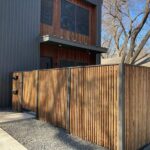
Good fences make good neighbors until it’s time to repair them. Heated debates and disputes can arise that sometimes end up in court. So it’s important to know who is responsible for fence repair on a property line. Well, it depends on where the fence falls and local laws.
Let’s break it down so you don’t have to worry about footing unnecessary repair — or legal — bills.
What is a Boundary Fence?
A boundary fence, also known as a shared, division, or partition fence, is located on the line between two landowners and “used” by both parties. While each state differs in what constitutes “use,” typically, it indicates that both sides are occupying the shared land, which this type of fence protects.
The cost and maintenance of boundary fences are typically split down the middle by both parties. But this isn’t always set in stone.
Who Owns the Fence?

The answer is usually determined by where the actual fence sits. If it’s on your side of the property line, you own it. If it’s on your neighbor’s side, it belongs to them.
But if it is directly on the line between you and your neighbor … well, that’s when things get tricky. The fence is owned by both parties in this scenario, and costs will be split evenly as well, assuming both neighbors are utilizing the fence.
If one party decided unilaterally to install a fence without consulting their neighbor first, the neighbor would still be liable for half of anything related to its upkeep and repair.
How To Prevent Fencing Issues with Your Neighbors
Things can get ugly between neighbors quickly if fences aren’t handled correctly. To preempt any drama, take steps to ensure everything is on the level. Here are the steps necessary to avoid issues over fence ownership:
Be Respectful, Communicate, and Reach an Agreement
The key to avoiding any issues or disputes surrounding who owns the fence is simply communicating. If planning updates, repairs, or a brand-new fence, it’s best to discuss your options with your neighbor beforehand. Some people may be open to compromise, while others will have their own ideas.
From the budget to the material used, there are lots of aspects to consider, which can be smoothed over by a friendly chat. Keep in mind that the finished side of the fence should always face outward as a courtesy to both your neighbor and passersby.
Observe Property Boundaries
Before you build, repair, or even discuss a boundary fence, be sure that you know (and your neighbor knows) precisely where each person’s property begins and ends. Don’t attempt to build in an area that isn’t yours, and don’t let your neighbor do it either without consulting you first. When in doubt, call a surveyor to get an official land assessment.
If your neighbor builds a fence with the sole purpose of annoying, harassing, or taunting you, it’s known as a spite fence. In such cases, local statutes may allow a court to stop the construction.
Check Local Fencing Regulations
Every town and city has its own set of regulations concerning fences. Do your homework before any work begins so you can stay on the right side of the law, no matter what happens with your neighbor.
Each state is different, so be sure you’re aware of your local statutes. In California, Civil Code 841 (Good Neighbor Fence Act of 2013) states: “Where a landowner intends to incur costs for a fence, the landowner shall give 30 days’ prior written notice to each affected adjoining landowner.”
In every state and city, there are height and length limits, setbacks, and other rules your professional fencing contractor must observe.
HOA Rules
If you’re part of a homeowners association, check the bylaws to see what rules and regulations your fencing project must adhere to.
In some HOAs, there may even be an approval process in place for boundary fences or, if there is a dispute, mediators available to arbitrate between the two parties. For instance, some HOAs may require any changes or repairs to be approved by the board before work can begin.
Most Common Scenarios for Fencing Disputes

Now that you have all the legal details out of the way, let’s look at a few common scenarios between neighbors and fencing:
One Neighbor Builds: Neighbors usually bear equal responsibility for maintaining a boundary fence, even if one person builds it without the other’s consent. The reason behind this is that it’s assumed both parties are benefiting from it.
One Neighbor Wants Removal: If one party wishes to do away with a boundary fence, don’t take it down without their input and permission. Otherwise, you might risk penalties or fines from your local government.
Neighbor Builds On Your Property: In case your neighbor decides to build a fence on your property, you should take it down as soon as possible. But make sure the area is actually your land and document everything in case a legal battle arises.
Home Purchase: If you’re purchasing a house with a fence in need of repair, make sure that you work it into the closing agreement or else those repairs are all yours after the deal is finished.
HOA or City Property: In other cases where your neighbor is a city property or your HOA, double-check all applicable regulations and bylaws before starting on any fence work. You might be in luck and find that local entities take care of the costs instead of the expense being divided.
FAQ About Fence Repair Responsibilities
If the fence is on your neighbor’s property, then no, you don’t have to pay for it. However, if the fence is located directly on the line between you and your neighbor, then both parties may use it and split the costs of its upkeep.
No. If it’s your neighbor’s property, then you are not allowed to make any changes to the fence without permission. If you cause damage or harm to their property when making repairs, they can sue you.
A typical residential boundary fence is 8 feet maximum. But keep in mind that local laws may limit these heights, so it’s important to check with your HOA, county, or city for clarification.
Go ahead and paint your side of the boundary fence, but make sure to use a brush instead of a sprayer. If the paint affects your neighbor’s property in any way, including their side of the fence, it can be your responsibility to remedy the situation.
Yes! Local fencing laws clearly state which materials are prohibited and outline height limits, but it’s likely your subdivision’s CC&Rs that will regulate the general aesthetic of the fence. If you’re not sure what regulations may apply to your project, be sure to check with local authorities.
The good news is that, depending on the cause of damage, your homeowner’s insurance should cover repairs to most fences. You likely have “other structures” coverage in your policy, which will typically cover damages due to vandalism, weather events, and other natural causes.
The amount of coverage usually caps out at 10% of your total policy coverage, but a good starting point is to review your policy in detail and call your insurance provider.
A Better Neighbor
Your next-door neighbor doesn’t need to be your worst enemy. A boundary fence shouldn’t ruin a peaceful relationship between homeowners.
Whether you’re sharing the costs of repairs or starting a fresh installation project, make sure to know your rights, stay on the right side of local regulations and ordinances, and communicate openly with your neighbor so you can stay on good terms.
Home Gnome delivers the best home service experience at the click of a button. Book reliable, skilled handymen and handywomen in seconds and leave the rest to us.
Read More:
Main Image Credit: New Africa / Adobe Stock




